Temperature Characteristics of a Pressure Sensor Based on BN/Graphene/BN Heterostructure
Abstract
:1. Introduction
2. Theoretical Analysis
3. Fabrication of the Sensor
4. Temperature Characteristic Measurement
5. Conclusions
Author Contributions
Funding
Conflicts of Interest
References
- He, Q.; Wu, S.; Gao, S.; Cao, X.; Yin, Z.; Li, H.; Chen, P.; Zhang, H. Transparent, Flexible, All-Reduced Graphene Oxide Thin Film Transistors. ACS Nano 2011, 5, 5038–5044. [Google Scholar] [CrossRef]
- Liu, G.; Jin, W.; Xu, N. Graphene-based membranes. Chem. Soc. Rev. 2015, 44, 5016–5030. [Google Scholar] [CrossRef]
- Lee, J.H.; Lee, E.K.; Joo, W.J.; Jang, Y.; Kim, B.S.; Lim, J.Y.; Choi, S.H.; Ahn, S.J.; Ahn, J.R.; Park, M.H.; et al. Wafer-Scale Growth of Single-Crystal Monolayer Graphene on Reusable Hydrogen-Terminated Germanium. Science 2014, 344, 286–289. [Google Scholar] [CrossRef]
- Pumera, M. Graphene-based nanomaterials and their electrochemistry. Chem. Soc. Rev. 2010, 39, 4146–4157. [Google Scholar] [CrossRef]
- Yang, Z.; Ren, J.; Zhang, Z.; Chen, X.; Guan, G.; Qiu, L.; Zhang, Y.; Peng, H. Recent Advancement of Nanostructured Carbon for Energy Applications. Chem. Rev. 2015, 115, 5159–5223. [Google Scholar] [CrossRef]
- Li, X.L.; Wang, X.R.; Zhang, L.; Lee, S.; Dai, H.J. Chemically derived, ultrasmooth graphene nanoribbon semiconductors. Science 2008, 319, 1229–1232. [Google Scholar] [CrossRef]
- Liu, Z.F.; Liu, Q.; Huang, Y.; Ma, Y.F.; Yin, S.G.; Zhang, X.Y.; Sun, W.; Chen, Y.S. Organic photovoltaic devices based on a novel acceptor material: Graphene. Adv. Mater 2008, 20, 3924–3930. [Google Scholar] [CrossRef]
- Pereira, V.M.; Castro Neto, A.H.; Peres, N.M.R. Tight-binding approach to uniaxial strain in graphene. Phy. Rev. B 2009, 80, 045401. [Google Scholar] [CrossRef]
- Sanaeepour, M.; Abedi, A.; Sharifi, M.J. Performance Analysis of Nanoscale Single Layer Graphene Pressure Sensors. IEEE Trans. Electron Devices 2017, 64, 1300–1304. [Google Scholar] [CrossRef]
- Pietro, C.; Athanassia, A.; Ilker, S. Graphene Nanoplatelets-Based Advanced Materials and Recent Progress in Sustainable Applications. Appl. Sci. 2018, 8, 1438. [Google Scholar]
- Pietro, C.; Simeone, D.; Luca, C.; Marco, M.; Lorenzo, N.; Giorgio, M.; Athanassia, A.; Ilker, B. Carbon Nanofiber versus Graphene-Based Stretchable Capacitive Touch Sensors for Artificial Electronic Skin. Adv. Sci. 2018, 5, 1870011. [Google Scholar]
- Tian, H.; Shu, Y.; Wang, X.-F.; Mohammad, M.A.; Bie, Z.; Xie, Q.-Y.; Li, C.; Mi, W.-T.; Yang, Y.; Ren, T.-L. A Graphene-Based Resistive Pressure Sensor with Record-High Sensitivity in a Wide Pressure Range. Sci. Rep. 2015, 5, 8603. [Google Scholar] [CrossRef]
- Tao, L.-Q.; Zhang, K.-N.; Tian, H.; Liu, Y.; Wang, D.-Y.; Chen, Y.-Q.; Yang, Y.; Ren, T.-L. Graphene-Paper Pressure Sensor for Detecting Human Motions. ACS Nano 2017, 11, 8790–8795. [Google Scholar] [CrossRef]
- Li, M.; Wu, C.; Zhao, S.; Deng, T.; Wang, J.; Liu, Z.; Wang, L.; Wang, G. Pressure sensing element based on the BN–graphene–BN heterostructure. Appl. Phys. Lett. 2018, 112, 143502. [Google Scholar] [CrossRef]
- Kim, D.G.; Kim, G.S.; Oh, S.T.; Kim, Y.D. The initial stage of sintering for the W–Cu nanocomposite powder prepared from W–CuO mixture. Mater. Lett. 2004, 58, 578–581. [Google Scholar] [CrossRef]
- Watanabe, K.; Taniguchi, T.; Kanda, H. Direct-bandgap properties and evidence for ultraviolet lasing of hexagonal boron nitride single crystal. Nat. Mater. 2004, 3, 404–409. [Google Scholar] [CrossRef]
- Song, W.L.; Wang, P.; Cao, L.; Anderson, A.; Meziani, M.J.; Farr, A.J.; Sun, Y.-P. Polymer/Boron Nitride Nanocomposite Materials for Superior Thermal Transport Performance. Angew. Chem. Int. Ed. 2012, 51, 6498–6501. [Google Scholar] [CrossRef]
- Tarrio, C.; Schnatterly, S.E. Interband Transitions, Plasmons, and Dispersion in Hexagonal Boron Nitride. Phys. Rev. B: Condens. Matter 1989, 40, 7852–7859. [Google Scholar] [CrossRef]
- Giovannetti, G.; Khomyakov, P.A.; Brocks, G.; Kelly, P.J.; Brink, J.V.D. Substrate-induced band gap in graphene on hexagonal boron nitride: Ab initio density functional calculations. Phys. Rev. B: Condens. Matter 2007, 76, 073103. [Google Scholar] [CrossRef]
- Hewitt, C.A.; Kaiser, A.B.; Craps, M.; Czerw, R.; Roth, S.; Carroll, D.L. Temperature dependent thermoelectric properties of freestanding few layer graphene/polyvinylidene fluoride composite thin films. Synth. Met. 2013, 165, 56–59. [Google Scholar] [CrossRef]
- Sun, P.; Zhu, M.; Wang, K.; Zhong, M.; Wei, J.; Wu, D.; Zhu, H. Small Temperature Coefficient of Resistivity of Graphene/Graphene Oxide Hybrid Membranes. ACS Appl. Mater. Interfaces 2013, 5, 9563–9571. [Google Scholar] [CrossRef] [PubMed]
- Cai, C.-H.; Qin, M. High-performance bulk silicon interdigital capacitive temperature sensor based on graphene oxide. Electron. Lett. 2013, 49, 488–490. [Google Scholar] [CrossRef]
- Kong, D.; Le, L.T.; Zunino, J.L.; Li, Y.; Lee, W. Temperature-Dependent Electrical Properties of Graphene Inkjet-Printed on Flexible Materials. Langmuir 2012, 28, 13467–13472. [Google Scholar] [CrossRef]
- Mousavi, H.; Khodadadi, J.; Kurdestany, J.M.; Yarmohammadi, Z. Electrical and thermal conductivities of the graphene, boron nitride and silicon boron honeycomb monolayers. Phys. Lett. A 2016, 380, 3823–3827. [Google Scholar] [CrossRef]
- Basko, M.D. Calculation of the Raman G peak intensity in monolayer graphene: Role of Ward identities. New J. Phys. 2009, 11, 095011. [Google Scholar] [CrossRef]
- Nika, D.L.; Askerov, A.S.; Balandin, A.A.; Pokatilov, E.P. Phonon thermal conduction in graphene: Role of Umklapp and edge roughness scattering. Phys. Rev. B 2009, 79, 155413. [Google Scholar] [CrossRef]
- Park, J.-Y.; Rosenblatt, S.; Yaish, Y.; Sazonova, V.; Üstünel, H.; Braig, S.; Arias, T.A.; Brouwer, P.W.; McEuen, P.L. Electron-Phonon Scattering in Metallic Single-Walled Carbon Nanotubes. Nano Letters 2003, 4, 517–520. [Google Scholar] [CrossRef]
- Prasher, R. Graphene Spreads the Heat. Science 2010, 328, 185–186. [Google Scholar] [CrossRef]
- Mousavi, H.; Bagheri, M. Effects of Holstein phonons on the electrical conductivity of carbon nanotubes. E Low-Dimens. Syst. Nanostruct. 2012, 44, 1722–1724. [Google Scholar] [CrossRef]
- Linh, D.K.; Khánh, N.Q. Electrical conductivity of bilayer-graphene double layers at finite temperature. Superlattices Microstruct. 2018, 114, 406–415. [Google Scholar] [CrossRef]
- Zhao, X.; Long, Y.; Yang, T.; Li, J.; Zhu, H. Simultaneous High Sensitivity Sensing of Temperature and Humidity with Graphene Woven Fabrics. ACS Appl. Mater. Interfaces 2017, 9, 30171–30176. [Google Scholar] [CrossRef]
- Davaji, B.; Cho, H.D.; Malakoutian, M.; Lee, J.K.; Panin, G.; Kang, T.W.; Lee, C.H. A patterned single layer graphene resistance temperature sensor. Sci. Rep. 2017, 7, 8811. [Google Scholar] [CrossRef]
- Karimov, K.S.; Chani, M.T.S.; Khalid, F.A. Carbon nanotubes film based temperature sensors. Phy. E: Low-dimensional Sys. Nanostruct. 2011, 43, 1701–1703. [Google Scholar] [CrossRef]
- Olsen, L.C. Electrical Transport Properties of Graphite Assuming Lattice Scattering. Phys. Rev. B 1972, 6, 4836–4845. [Google Scholar] [CrossRef]
- Ali, K.; Hafez, M. Growth and structure of carbon nanotubes based novel catalyst for ultrafast nano-temperature sensor application. Superlattices Microstruct. 2013, 54, 1–6. [Google Scholar] [CrossRef]
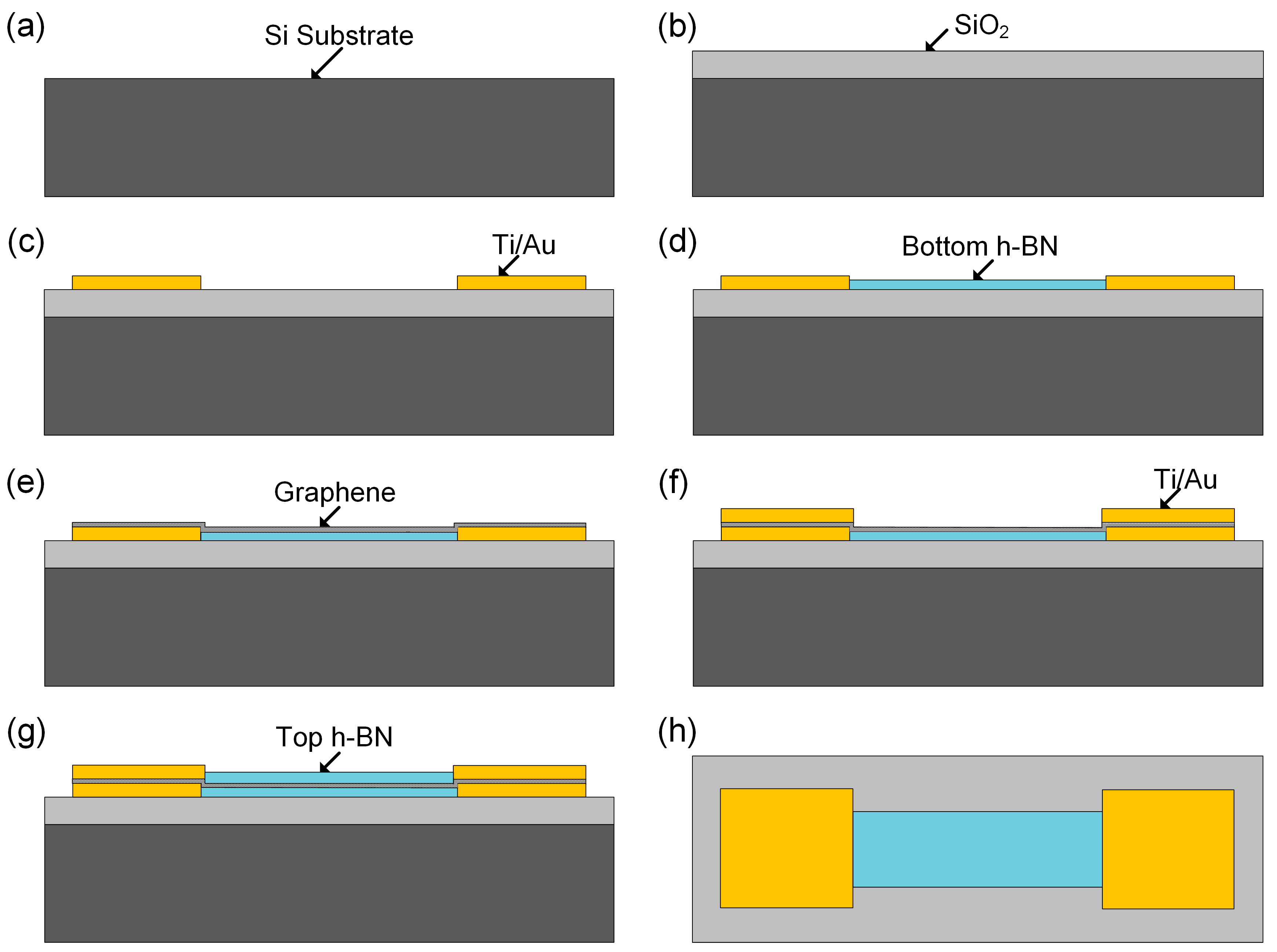
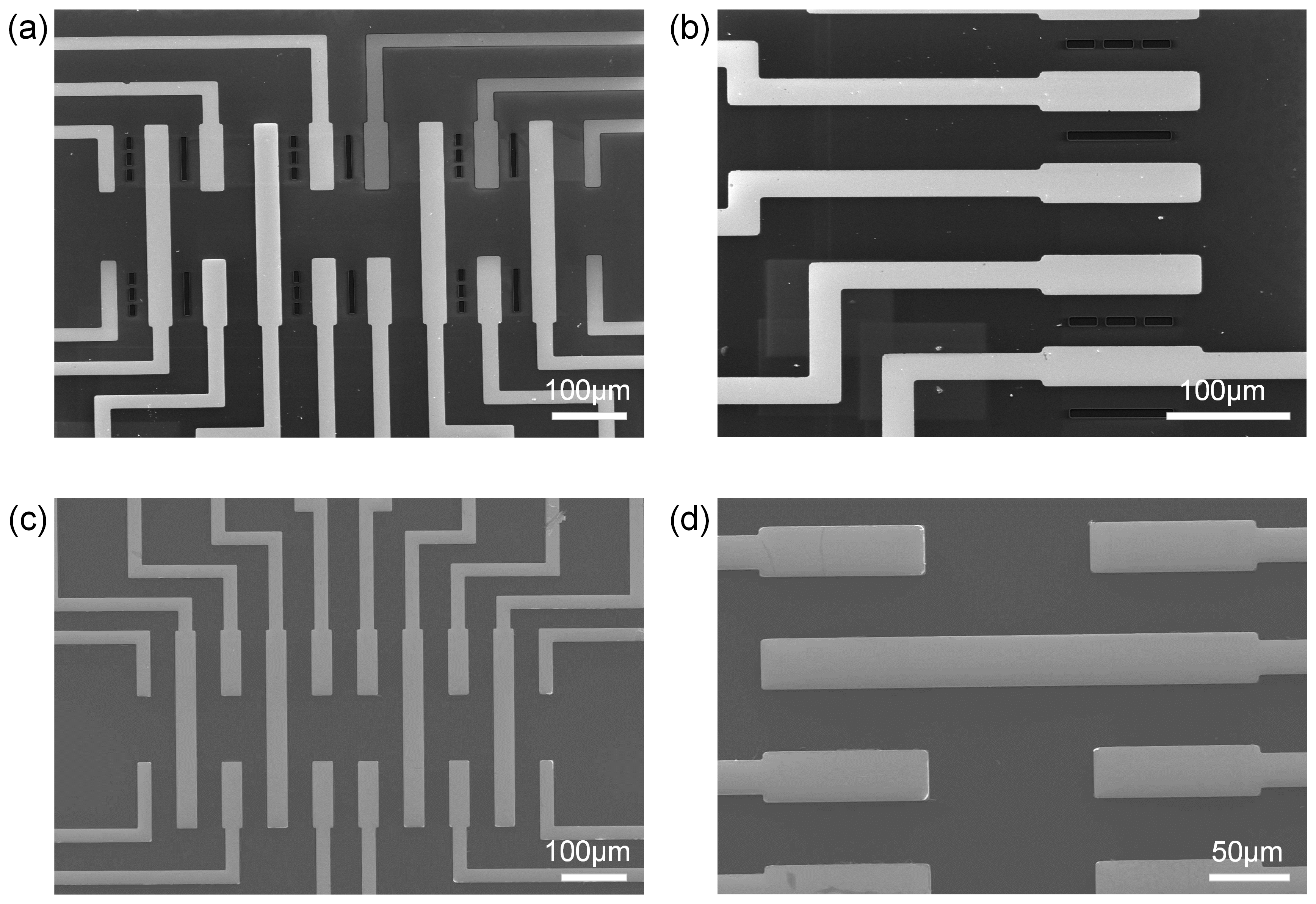
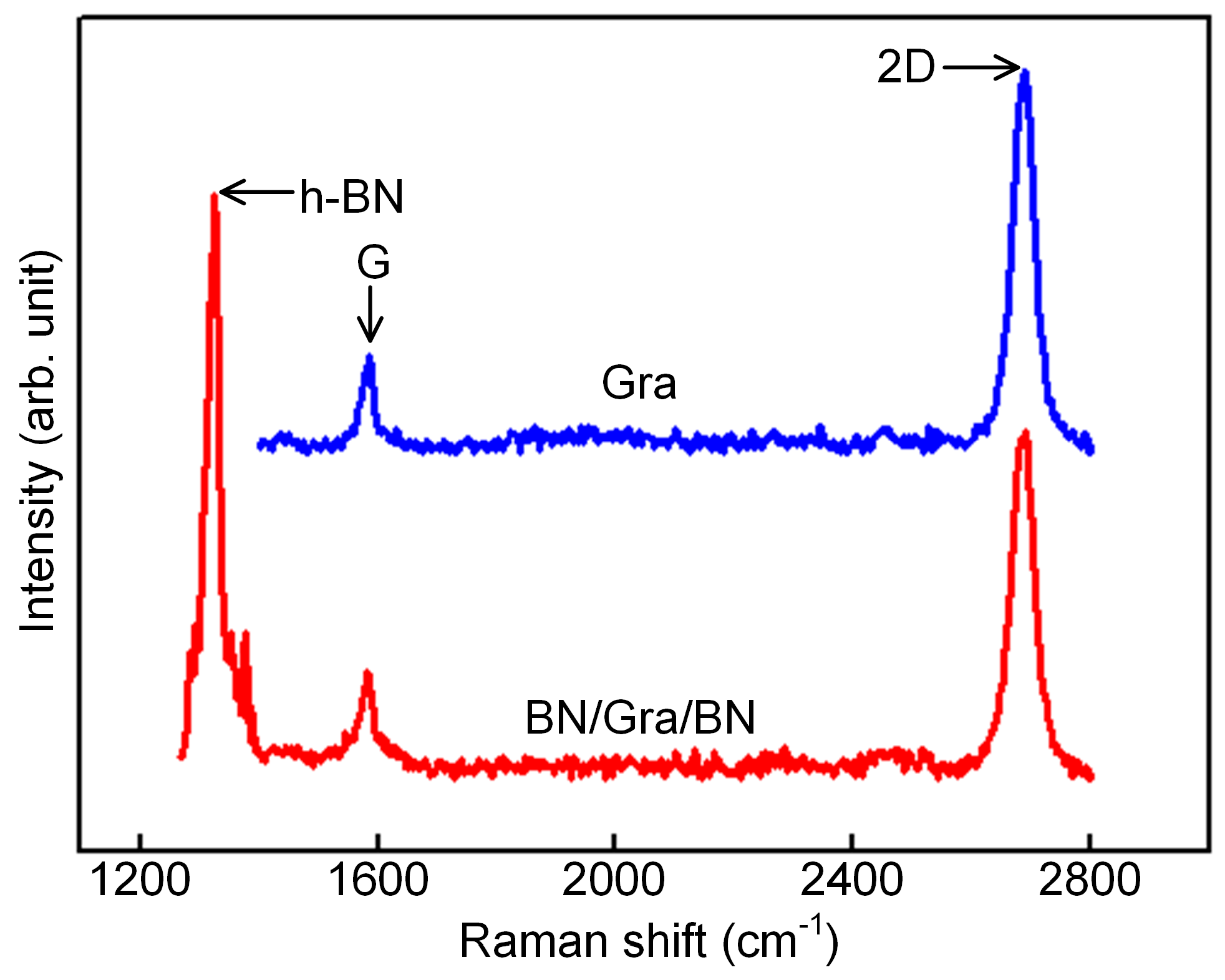
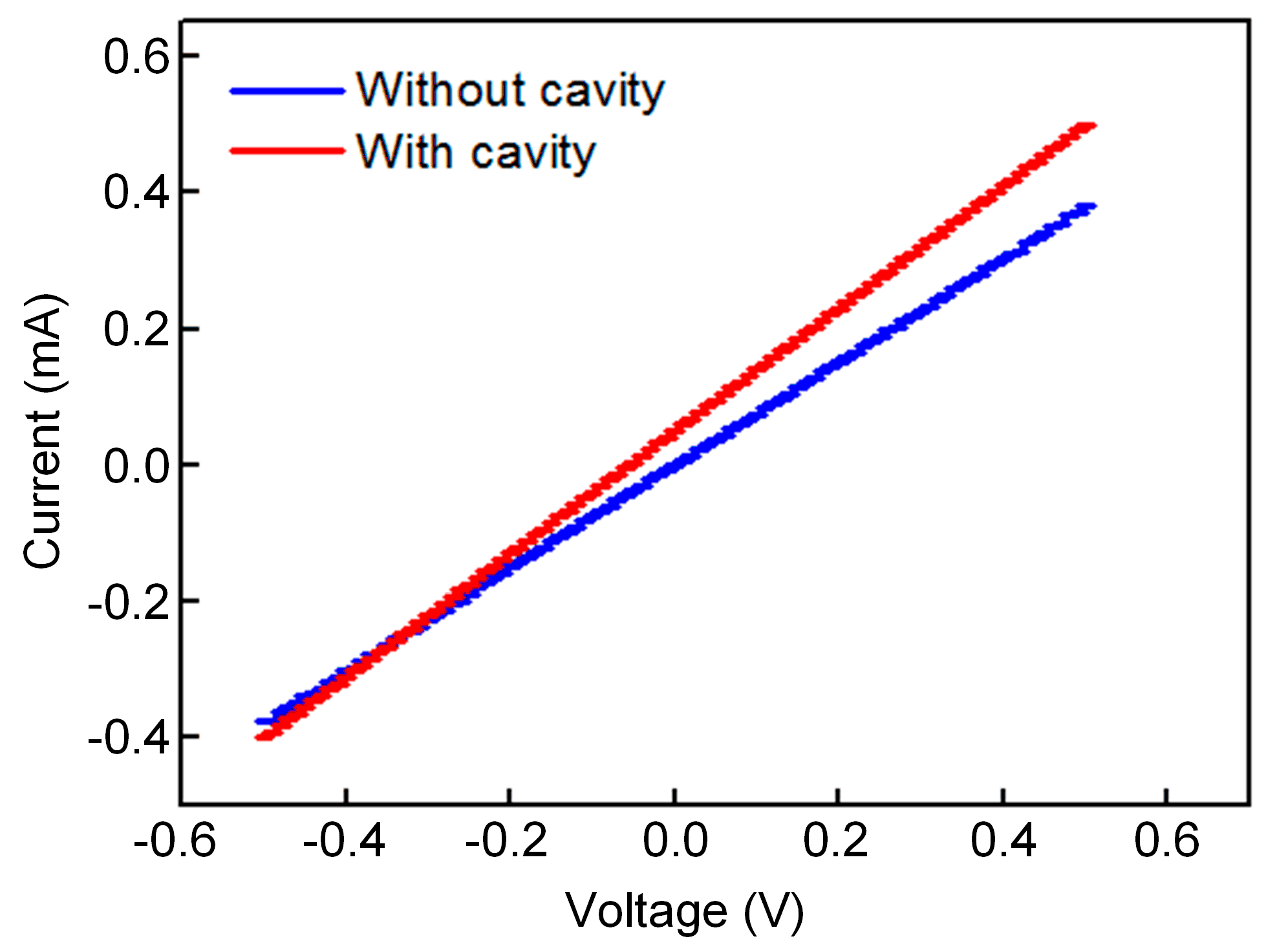
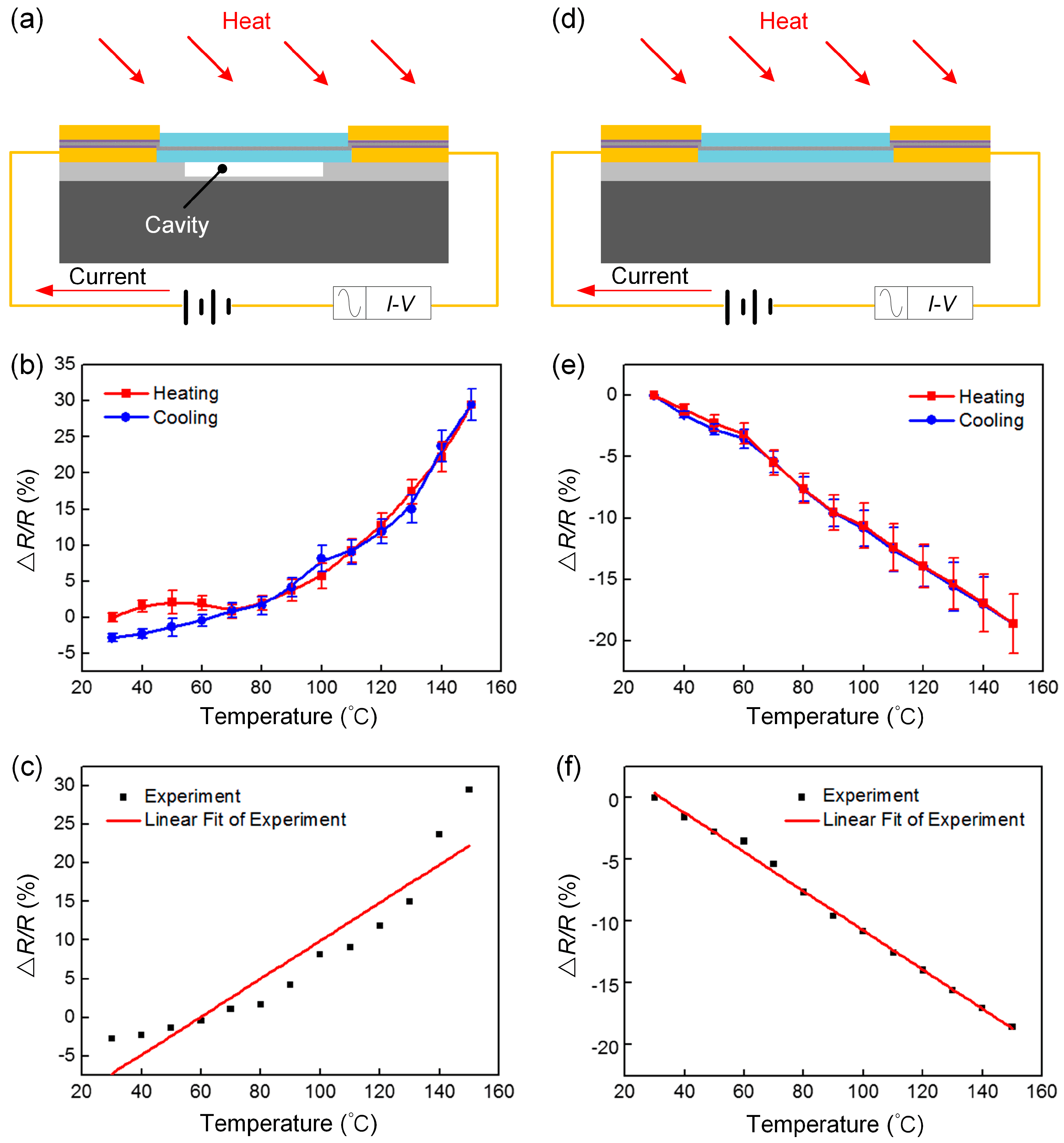
| Sensor Type | Temperature Coefficient | References |
|---|---|---|
| The BN/Gra/BN pressure sensors with a cavity | 0.25%°C−1 | This work |
| The BN/Gra/BN pressure sensors without a cavity | −0.16%°C−1 | This work |
| Monolayer graphene | 0.10%°C−1 | [32] |
| Multi-walled CNTs | −0.13%°C−1 | [33] |
| Graphite | 0.05%°C−1 | [34] |
| CNTs prepared by CVD | 0.04%°C−1 | [35] |
© 2019 by the authors. Licensee MDPI, Basel, Switzerland. This article is an open access article distributed under the terms and conditions of the Creative Commons Attribution (CC BY) license (http://creativecommons.org/licenses/by/4.0/).
Share and Cite
Li, M.; Zhang, T.; Wang, P.; Li, M.; Wang, J.; Liu, Z. Temperature Characteristics of a Pressure Sensor Based on BN/Graphene/BN Heterostructure. Sensors 2019, 19, 2223. https://doi.org/10.3390/s19102223
Li M, Zhang T, Wang P, Li M, Wang J, Liu Z. Temperature Characteristics of a Pressure Sensor Based on BN/Graphene/BN Heterostructure. Sensors. 2019; 19(10):2223. https://doi.org/10.3390/s19102223
Chicago/Turabian StyleLi, Mengwei, Teng Zhang, Pengcheng Wang, Minghao Li, Junqiang Wang, and Zewen Liu. 2019. "Temperature Characteristics of a Pressure Sensor Based on BN/Graphene/BN Heterostructure" Sensors 19, no. 10: 2223. https://doi.org/10.3390/s19102223
APA StyleLi, M., Zhang, T., Wang, P., Li, M., Wang, J., & Liu, Z. (2019). Temperature Characteristics of a Pressure Sensor Based on BN/Graphene/BN Heterostructure. Sensors, 19(10), 2223. https://doi.org/10.3390/s19102223




